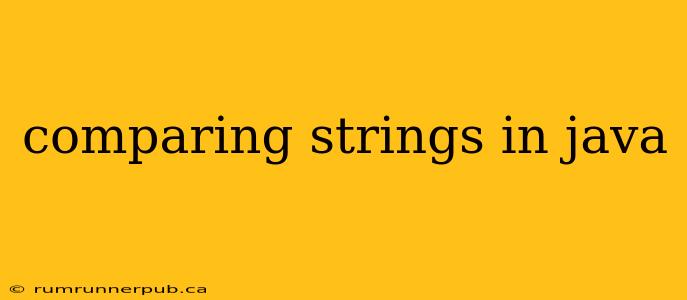Java offers several ways to compare strings, each with its own nuances and best-use cases. Understanding these differences is crucial for writing efficient and correct Java code. This article explores various string comparison methods, drawing upon insightful Stack Overflow discussions to provide a clear and comprehensive overview.
The Fundamental Methods: equals() and ==
The most common methods for comparing strings are equals() and ==. However, their behaviors are distinctly different:
-
==: This operator compares object references. It checks if two string variables point to the same memory location. This means it's testing for identity, not equality of content. -
equals(): This method compares the content of two strings. It checks if the strings have the same sequence of characters. This is generally what you want when comparing strings for equality.
Example (Illustrating the difference):
String str1 = "hello";
String str2 = "hello";
String str3 = new String("hello");
System.out.println(str1 == str2); // Output: true (same memory location due to string interning)
System.out.println(str1 == str3); // Output: false (different memory locations)
System.out.println(str1.equals(str2)); // Output: true (same content)
System.out.println(str1.equals(str3)); // Output: true (same content)
This example, inspired by common Stack Overflow questions about string comparison, highlights the crucial difference. While str1 and str2 might point to the same object due to Java's string interning (a compiler optimization), str3 explicitly creates a new string object with the same content. Only equals() reliably checks for content equality.
(Note: String interning is not guaranteed for all cases, especially with dynamically created strings.)
Case-Insensitive Comparisons: equalsIgnoreCase()
Often, you need to compare strings without considering case differences. Java provides the equalsIgnoreCase() method for this purpose:
String str4 = "Hello";
String str5 = "hello";
System.out.println(str4.equalsIgnoreCase(str5)); // Output: true
This method is a convenient and efficient way to perform case-insensitive comparisons, avoiding the need for manual case conversion. This is particularly useful when dealing with user input where capitalization might vary.
Comparing Strings Lexicographically: compareTo() and compareToIgnoreCase()
For lexicographical comparisons (comparing strings in alphabetical order), Java's compareTo() and compareToIgnoreCase() methods are essential. These methods return an integer:
- Negative value: The string calling the method comes before the argument string lexicographically.
- Zero: The strings are equal.
- Positive value: The string calling the method comes after the argument string lexicographically.
String str6 = "apple";
String str7 = "banana";
String str8 = "Apple";
System.out.println(str6.compareTo(str7)); // Output: negative value (apple comes before banana)
System.out.println(str6.compareToIgnoreCase(str8)); // Output: 0 (case-insensitive comparison yields equality)
This functionality is often used in sorting algorithms and other scenarios where string order matters. The compareToIgnoreCase() method provides case-insensitive lexicographical comparison.
Handling Nulls: Robust Comparison
A common pitfall is forgetting to handle null strings. Attempting to call methods on a null string will result in a NullPointerException. Always check for nulls before performing any comparison:
String str9 = null;
String str10 = "test";
if (str9 != null && str9.equals(str10)) {
// ...
} else if (str9 == null){
// handle null string case
}
This defensive programming approach prevents unexpected crashes and enhances the robustness of your code. This is advice frequently repeated on Stack Overflow, emphasizing the importance of null checks.
Conclusion
Choosing the right string comparison method in Java depends on your specific needs. While equals() is the workhorse for content comparison, equalsIgnoreCase(), compareTo(), and compareToIgnoreCase() offer specialized functionalities. Remember to always handle potential null values gracefully to maintain the stability and reliability of your application. By understanding these differences and best practices, you can avoid common pitfalls and write more efficient and robust Java code.
